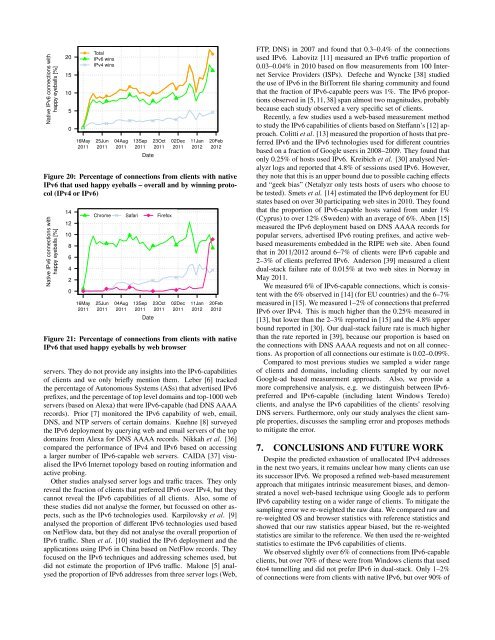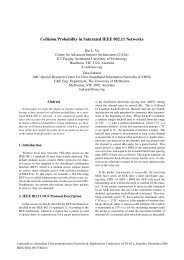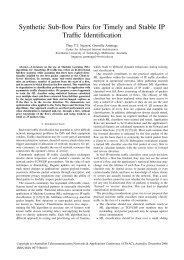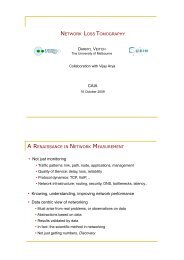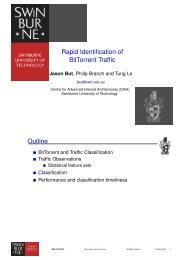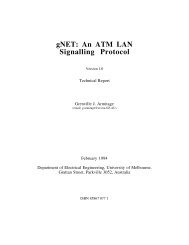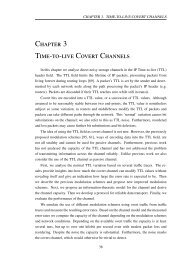Mitigating Sampling Error when Measuring Internet Client IPv6 ...
Mitigating Sampling Error when Measuring Internet Client IPv6 ...
Mitigating Sampling Error when Measuring Internet Client IPv6 ...
Create successful ePaper yourself
Turn your PDF publications into a flip-book with our unique Google optimized e-Paper software.
Native <strong>IPv6</strong> connections with<br />
happy eyeballs [%]<br />
Native <strong>IPv6</strong> connections with<br />
happy eyeballs [%]<br />
Percentage of native v6 capable that use happy eyeballs<br />
20<br />
● Total<br />
<strong>IPv6</strong> wins<br />
●<br />
FTP, DNS) in 2007 and found that 0.3–0.4% of the connections<br />
used <strong>IPv6</strong>. Labovitz [11] measured an <strong>IPv6</strong> traffic proportion of<br />
IPv4 wins<br />
0.03–0.04% in 2010 based on flow measurements from 100 Inter-<br />
15<br />
net Service Providers (ISPs). Defeche and Wyncke [38] studied<br />
10<br />
●<br />
●<br />
●<br />
●<br />
the use of <strong>IPv6</strong> in the BitTorrent file sharing community and found<br />
that the fraction of <strong>IPv6</strong>-capable peers was 1%. The <strong>IPv6</strong> proportions<br />
observed in [5, 11, 38] span almost two magnitudes, probably<br />
5<br />
because each study observed a very specific set of clients.<br />
Recently, a few studies used a web-based measurement method<br />
0<br />
●<br />
to study the <strong>IPv6</strong> capabilities of clients based on Steffann’s [12] approach.<br />
Colitti et al. [13] measured the proportion of hosts that pre-<br />
16May<br />
2011<br />
25Jun<br />
2011<br />
04Aug<br />
2011<br />
13Sep 23Oct<br />
2011 2011<br />
Date<br />
02Dec<br />
2011<br />
11Jan<br />
2012<br />
20Feb<br />
2012<br />
ferred <strong>IPv6</strong> and the <strong>IPv6</strong> technologies used for different countries<br />
based on a fraction of Google users in 2008–2009. They found that<br />
only 0.25% of hosts used <strong>IPv6</strong>. Kreibich et al. [30] analysed Netalyzr<br />
logs and reported that 4.8% of sessions used <strong>IPv6</strong>. However,<br />
Figure 20: Percentage of connections from clients with native they note that this is an upper bound due to possible caching effects<br />
<strong>IPv6</strong> that used happy eyeballs – overall and by winning proto- and “geek bias” (Netalyzr only tests hosts of users who choose to<br />
col (IPv4 or <strong>IPv6</strong>)<br />
be tested). Smets et al. [14] estimated the <strong>IPv6</strong> deployment for EU<br />
ercentage of unicast v6 capable that use happy eyeballs by browser states based on over 30 participating web sites in 2010. They found<br />
14<br />
12<br />
Chrome Safari Firefox<br />
that the proportion of <strong>IPv6</strong>-capable hosts varied from under 1%<br />
(Cyprus) to over 12% (Sweden) with an average of 6%. Aben [15]<br />
measured the <strong>IPv6</strong> deployment based on DNS AAAA records for<br />
10<br />
popular servers, advertised <strong>IPv6</strong> routing prefixes, and active web-<br />
8<br />
6<br />
based measurements embedded in the RIPE web site. Aben found<br />
that in 2011/2012 around 6–7% of clients were <strong>IPv6</strong> capable and<br />
2–3% of clients preferred <strong>IPv6</strong>. Anderson [39] measured a client<br />
4<br />
dual-stack failure rate of 0.015% at two web sites in Norway in<br />
2<br />
0<br />
May 2011.<br />
We measured 6% of <strong>IPv6</strong>-capable connections, which is consistent<br />
with the 6% observed in [14] (for EU countries) and the 6–7%<br />
16May 25Jun 04Aug 13Sep 23Oct 02Dec 11Jan 20Feb measured in [15]. We measured 1–2% of connections that preferred<br />
2011 2011 2011 2011 2011 2011 2012 2012 <strong>IPv6</strong> over IPv4. This is much higher than the 0.25% measured in<br />
Date<br />
[13], but lower than the 2–3% reported in [15] and the 4.8% upper<br />
bound reported in [30]. Our dual-stack failure rate is much higher<br />
Figure 21: Percentage of connections from clients with native<br />
<strong>IPv6</strong> that used happy eyeballs by web browser<br />
than the rate reported in [39], because our proportion is based on<br />
the connections with DNS AAAA requests and not on all connections.<br />
As proportion of all connections our estimate is 0.02–0.09%.<br />
Compared to most previous studies we sampled a wider range<br />
of clients and domains, including clients sampled by our novel<br />
Google-ad based measurement approach. Also, we provide a<br />
more comprehensive analysis, e.g. we distinguish between <strong>IPv6</strong>preferred<br />
and <strong>IPv6</strong>-capable (including latent Windows Teredo)<br />
clients, and analyse the <strong>IPv6</strong> capabilities of the clients’ resolving<br />
DNS servers. Furthermore, only our study analyses the client sample<br />
properties, discusses the sampling error and proposes methods<br />
to mitigate the error.<br />
servers. They do not provide any insights into the <strong>IPv6</strong>-capabilities<br />
of clients and we only briefly mention them. Leber [6] tracked<br />
the percentage of Autonomous Systems (ASs) that advertised <strong>IPv6</strong><br />
prefixes, and the percentage of top level domains and top-1000 web<br />
servers (based on Alexa) that were <strong>IPv6</strong>-capable (had DNS AAAA<br />
records). Prior [7] monitored the <strong>IPv6</strong> capability of web, email,<br />
DNS, and NTP servers of certain domains. Kuehne [8] surveyed<br />
the <strong>IPv6</strong> deployment by querying web and email servers of the top<br />
domains from Alexa for DNS AAAA records. Nikkah et al. [36]<br />
compared the performance of IPv4 and <strong>IPv6</strong> based on accessing<br />
a larger number of <strong>IPv6</strong>-capable web servers. CAIDA [37] visualised<br />
the <strong>IPv6</strong> <strong>Internet</strong> topology based on routing information and<br />
active probing.<br />
Other studies analysed server logs and traffic traces. They only<br />
reveal the fraction of clients that preferred <strong>IPv6</strong> over IPv4, but they<br />
cannot reveal the <strong>IPv6</strong> capabilities of all clients. Also, some of<br />
these studies did not analyse the former, but focussed on other aspects,<br />
such as the <strong>IPv6</strong> technologies used. Karpilovsky et al. [9]<br />
analysed the proportion of different <strong>IPv6</strong> technologies used based<br />
on NetFlow data, but they did not analyse the overall proportion of<br />
<strong>IPv6</strong> traffic. Shen et al. [10] studied the <strong>IPv6</strong> deployment and the<br />
applications using <strong>IPv6</strong> in China based on NetFlow records. They<br />
focused on the <strong>IPv6</strong> techniques and addressing schemes used, but<br />
did not estimate the proportion of <strong>IPv6</strong> traffic. Malone [5] analysed<br />
the proportion of <strong>IPv6</strong> addresses from three server logs (Web,<br />
7. CONCLUSIONS AND FUTURE WORK<br />
Despite the predicted exhaustion of unallocated IPv4 addresses<br />
in the next two years, it remains unclear how many clients can use<br />
its successor <strong>IPv6</strong>. We proposed a refined web-based measurement<br />
approach that mitigates intrinsic measurement biases, and demonstrated<br />
a novel web-based technique using Google ads to perform<br />
<strong>IPv6</strong> capability testing on a wider range of clients. To mitigate the<br />
sampling error we re-weighted the raw data. We compared raw and<br />
re-weighted OS and browser statistics with reference statistics and<br />
showed that our raw statistics appear biased, but the re-weighted<br />
statistics are similar to the reference. We then used the re-weighted<br />
statistics to estimate the <strong>IPv6</strong> capabilities of clients.<br />
We observed slightly over 6% of connections from <strong>IPv6</strong>-capable<br />
clients, but over 70% of these were from Windows clients that used<br />
6to4 tunnelling and did not prefer <strong>IPv6</strong> in dual-stack. Only 1–2%<br />
of connections were from clients with native <strong>IPv6</strong>, but over 90% of


